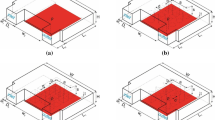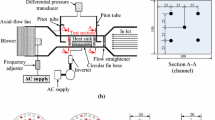Abstract
In this study, the simulation of the coolant flow using micro-pin fins in the CPU heat sink was numerically presented with ANSYS-Fluent, a Computational Fluid Dynamics (CFD) program. Four different inlet–outlet configurations were employed in the heat sink. Keeping the inlet position of the flow to the heat sink fixed, the effects of the outlet position change on the pressure drop and thermal performance were examined. The flow field and heat transfer of each case were simulated with the SST k-ω turbulence model, three-dimensional study of steady, incompressible flow. In the study, a 2 mm diameter copper tube was used in the staggered arrangement fins array with the 0.23 porosity value. Reynolds number was in the range of 5000 < Re < 12,000 and 2 kW/m2 constant heat flux to the cooling base was taken into consideration boundary conditions. Velocity streamlines, TKE and temperature distributions, Nusselt number (Nu), skin friction values (f), pressure drop (ΔP), thermal resistance (Rth) and performance criterion (PEC) changes were presented to detail the hydrodynamic and thermal performance characteristics along the heat sink surface with the increase of Reynolds number. Results showed that as the Reynolds number increased, Nusselt number increased and skin friction decreased. In addition to the improvement in heat transfer for the finned models considered according to the finless cooler, the results show that the input–output configurations make a minimum difference of 32.25% in the performance criteria. The significance and novelty of this investigation consist in a consideration of an electronic devices cooling system, as well as an assessment of the influence of inlet/outlet configuration on the cooling process for a CPU.

















Similar content being viewed by others
Abbreviations
- A:
-
Area
- cp :
-
Specific heat at constant pressure, (kJ/kg K)
- Dh :
-
Hydraulic diameter, (mm)
- f:
-
Friction factor
- H:
-
Height of channel (mm) (see Fig. 1)
- L:
-
Length of the channel (see Fig. 1)
- h:
-
Heat transfer coefficient, (W/m2 K)
- k:
-
Thermal conductivity (W/m K)
- Nu:
-
Nusselt number
- P:
-
Pressure, (Pa)
- q”:
-
Heat flux (W/m2)
- Re:
-
Reynolds number
- T:
-
Temperature, (K, °C)
- Um :
-
Mean velocity, (m/s)
- w:
-
Width (mm)
- Rt:
-
Thermal resistance
- x, y, z:
-
Cartesian coordinates
- ρ:
-
Density
- μ:
-
Viscosity, (Pa s)
- s:
-
Surface
- avg:
-
Average
- SST:
-
Shear stress transport
- TKE:
-
Turbulence kinetic energy
References
J.F. Tullius, T.K. Tullius, Y. Bayazitoglu, Optimization of short micro pin fins in minichannels. Int. J. Heat Mass Transf. 55(15–16), 3921–3932 (2012)
Y.K. Prajapati, Influence of fin height on heat transfer and fluid flow characteristics of rectangular microchannel heat sink. Int. J. Heat Mass Transf. 137, 1041–1052 (2019)
G.V. Kewalramani, G. Hedau, S.K. Saha, A. Agrawal, Study of laminar single phase frictional factor and Nusselt number in In-line micro pin-fin heat sink for electronic cooling applications. Int. J. Heat Mass Transf. 138, 796–808 (2019)
T.H. Tsai, R. Chein, Performance analysis of nanofluid-cooled microchannel heat sinks. Int. J. Heat Fluid Flow 28(5), 1013–1026 (2007)
C.J. Ho, L.C. Wei, Z.W. Li, An experimental investigation of forced convective cooling performance of a microchannel heat sink with Al2O3/water nanofluid. Appl. Therm. Eng. 30(2–3), 96–103 (2010)
M.I. Hasan, Investigation of flow and heat transfer characteristics in micro pin fin heat sink with nanofluid. Appl. Therm. Eng. 63(2), 598–607 (2014)
T. Hempijid, C. Kittichaikarn, Effect of heat sink inlet and outlet flow direction on heat transfer performance. Appl. Therm. Eng. 164, 114375 (2020)
Y. Peles, A. Kos, C. Mishra, C. Kuo, B. Schneider, Forced convective heat transfer across a pin fin micro heat sink. Int. J. Heat Mass Transf. 48, 3615–3627 (2005)
W. Qu, A. Siu-ho, Measurement and prediction of pressure drop in a two-phase micro-pin-fin heat sink. Int. J. Heat Mass Transf. 52(21–22), 5173–5184 (2009)
T. Ambreen, A. Saleem, S.A. Shehzad, C. Woo, Performance analysis of hybrid nano fluid in a heat sink equipped with sharp and streamlined micro pin- fins. Powder Technol. 355, 552–563 (2019)
H. Chiu, R. Hsieh, K. Wang, J. Jang, C. Yu, The heat transfer characteristics of liquid cooling heat sink with micro pin fi ns. Int. Commun. Heat Mass Transf. 86, 174–180 (2017)
W. Yuan, J. Zhao, C.P. Tso, T. Wu, W. Liu, T. Ming, Numerical simulation of the thermal hydraulic performance of a plate pin fi n heat sink. Appl. Therm. Eng. 48, 81–88 (2012)
L. Gong, J. Zhao, S. Huang, Numerical study on layout of micro-channel heat sink for thermal management of electronic devices. Appl. Therm. Eng. 88, 480–490 (2015)
H.E. Ahmed, B.H. Salman, A.S. Kherbeet, M.I. Ahmed, Optimization of thermal design of heat sinks: a review. Int. J. Heat Mass Transf. 118, 129–153 (2018)
D. Sahel, L. Bellahcene, A. Yousfi, A. Subasi, Numerical investigation and optimization of a heat sink having hemispherical pin fins. Int. Commun. Heat Mass Transf. 122, 105133 (2021)
A.A. Hussain, B. Freegah, B.S. Khalaf, H. Towsyfyan, Numerical investigation of heat transfer enhancement in plate-fin heat sinks: effect of flow direction and fillet profile. Case Stud. Therm. Eng. 13, 2019 (2018)
X. Wang, M. Chen, D. Tate, H. Rahimi, S. Zhang, Numerical investigation on hydraulic and thermal characteristics of micro latticed pin fin in the heat sink. Int. J. Heat Mass Transf. 149, 119157 (2020)
Y. Wang, K. Zhu, Z. Cui, J. Wei, Effects of the location of the inlet and outlet on heat transfer performance in pin fin CPU heat sink. Appl. Therm. Eng. 151, 506–513 (2019)
S. Bhattacharyya, B. Souayeh, A. Banerjee, R. Sarkar, Numerical analysis of micro-pin-fin heat sink cooling in the mainboard chip of a CPU. Eur. Phys. J. Plus 123, 1–10 (2020)
N. Sahiti, A. Lemouedda, D. Stojkovic, F. Durst, E. Franz, Performance comparison of pin fin in-duct flow arrays with various pin cross-sections. Appl. Therm. Eng. 26(11–12), 1176–1192 (2006)
H.R. Seyf, M. Feizbakhshi, Computational analysis of nanofluid effects on convective heat transfer enhancement of micro-pin-fin heat sinks. Int. J. Therm. Sci. 58, 168–179 (2012)
O. Manca, S. Nardini, D. Ricci, A numerical study of nano fl uid forced convection in ribbed channels. Appl. Therm. Eng. 37, 280–292 (2012)
A. Pina, P. Ferrão, J. Fournier, B. Lacarrière, O. Le Corre, Heat transfer enhancement of a molten salt parabolic trough solar receiver with concentric and eccentric pipe inserts. Energy Procedia 142, 624–629 (2017)
R.L. Webb, N.Y. Kim, Enhanced Heat Transfer (Taylor and Francis, NY, 2005)
Author information
Authors and Affiliations
Corresponding author
Rights and permissions
About this article
Cite this article
Koca, F., Zabun, M. The effect of outlet location on heat transfer performance in micro pin-fin cooling used for a CPU. Eur. Phys. J. Plus 136, 1115 (2021). https://doi.org/10.1140/epjp/s13360-021-02113-4
Received:
Accepted:
Published:
DOI: https://doi.org/10.1140/epjp/s13360-021-02113-4




